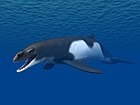Plesiocetus
| Plesiocetus | |
|---|---|
| Scientific classification | |
| Kingdom: | Animalia |
| Phylum: | Chordata |
| Class: | Mammalia |
| Order: | Artiodactyla |
| Infraorder: | Cetacea |
| Family: | Balaenopteridae |
| Genus: | †Plesiocetus Van Beneden 1859 |
| Species | |
| |
| Synonyms | |
| |
Plesiocetus is a genus of extinct balaenopterids found worldwide. It has had a chequered taxonomic history, having served as a wastebasket genus for a handful of mysticete species.
Taxonomy[]
The genus Plesiocetus was originally coined for three mysticete species from Neogene marine deposits in the vicinity of Antwerp, Belgium: P. garopii, P. hupschii, and P. burtinii.[1]
The three originally included species of Plesiocetus went about their separate ways. P. garopii was designated the type species of the genus, while the other two were referred to Cetotherium.[2](P. hupschii and P. burtinii were later assigned to , which was originally erected as a subgenus of Cetotherium[3]) Later, van Beneden noted the similarities of Plesiocetus with the fin whale, so he renamed Plesiocetus garopii into Balaenoptera musculoides, which is invalid under current ICZN rules. At the same time, he also erected the new species P. brialmontii on the basis of fragmentary remains, while referring Cetotherium dubius to Plesiocetus.
The taxonomy of Plesiocetus by now was confused. Plesiocetus garopii was referred to Balaenoptera (making Plesiocetus a synonym of Balaenoptera), while P. hupschii and P. burtinii were assigned to Cetotherium.[4][5] To avoid nomenclatorial complications, Plesiocetus hupschii was designated the type species of Plesiocetopsis, removing any synonymy between Plesiocetus and Plesiocetopsis.[6] Recent studies, however, indicate that Plesiocetus shares no characters with Balaenoptera to the exclusion of other balaenopterids.[7][8] For its part, P. burtinii was referred to Aglaocetus, while P. brialmontii was declared a nomen dubium.[8] These revisions leave P. garopii the type and only species of Plesiocetus.
Distribution[]
Fossils of Plesiocetus have been found in:[9]
- Neogene
- Gaimán Formation, Argentina
- , and , Belgium
- Navidad Formation, Chile
- Mont-de-Marsan and Poussan, France
- , Netherlands
- Quaternary
References[]
- ^ Van Beneden, P.-J. 1859. Sur la découverte d’ossements fossiles faite à Saint-Nicolas. Bulletin de l’Academie Royale des Sciences, des Lettres et des Beaux-Arts de Belgique, Series 2, 8: 123–146.
- ^ Van Beneden, P.-J. 1872. Les baleines fossiles d’Anvers. Bulletin de l’Academie Royale des Sciences, des Lettres et des Beaux-Arts de Belgique, Series 2, 40: 736–758.
- ^ Brandt, J. F. 1873. Untersuchungen über die fossilen und subfossilen cetaceen Europa's. Mémoires de l’Académie Impériale des Sciences de St.-Pétersbourg, Series 7, 20(1): 1–372.
- ^ Deméré, T. 1986. The fossil whale, Balaenoptera davidsonii (Cope 1872), with a review of other Neogene species of Balaenoptera (Cetacea: Mysticeti). Marine Mammal Science, 2: 277–298.
- ^ Lydekker, R. 1887. Catalogue of the Fossil Mammalia in the British Museum (Natural History), Vol. 5, 1–345. London: British Museum (Natural History).
- ^ Kellogg, R. 1931. Pelagic mammals of the Temblor Formation of the Kern River region, California. Proceedings of the California Academy of Sciences, 19(12): 217–397.
- ^ Deméré, T., Berta, A. and McGoven, M. R. 2005. The taxonomic and evolutionary history of fossil and modern balaenopteroid mysticetes. Journal of Mammalian Evolution, 12: 99–143.
- ^ a b Steeman, M. E. (March 2010). "The extinct baleen whale fauna from the Miocene-Pliocene of Belgium and the diagnostic cetacean ear bones". Journal of Systematic Palaeontology 8 (1): 63–80. doi:10.1080/14772011003594961.
- ^ Plesiocetus at Fossilworks.org
- Baleen whales
- Prehistoric cetacean genera
- Miocene cetaceans
- Pliocene cetaceans
- Pleistocene cetaceans
- Miocene mammals of Europe
- Pliocene mammals of Europe
- Pleistocene mammals of Europe
- Neogene United Kingdom
- Fossils of Belgium
- Fossils of Denmark
- Fossils of France
- Fossils of Germany
- Fossils of Italy
- Fossils of the Netherlands
- Fossils of England
- Miocene mammals of North America
- Pliocene mammals of North America
- Neogene Mexico
- Fossils of Mexico
- Neogene United States
- Fossils of North Carolina
- Miocene mammals of South America
- Neogene Argentina
- Fossils of Argentina
- Gaiman Formation
- Neogene Chile
- Fossils of Chile
- Fossil taxa described in 1859



